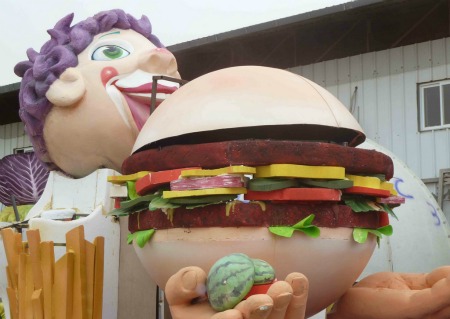
With paintbrushes at the ready, artist Zipi Ifat is putting the final touches on the floats set to feature in this year’s national Adloyada Purim Parade in Holon, March 8.
There’s a giant falafel, an enormous hamburger, a huge schnitzel and cartoon characters laden with food. This year’s theme, Tastes of Childhood, also includes Peter Pan covered in ice cream cones, Popeye eating spinach, and a giant’s face made of fruit and vegetables.
“Of course I still get excited. Every year it’s a new subject and that means a new creation,” Ifat tells ISRAEL21c days before the 2012 parade. “I feel proud even after so many years of doing this. Everything has gotten bigger.”
The name “Adloyada” comes from the decree that on Purim Jews should drink until they cannot tell the difference (ad lo yada) between the holiday’s main characters, the evil Haman and the heroic Mordechai. The Holon Adloyada is not about intoxication due to alcohol but rather due to excitement.
The 64-year-old Ifat has been the national parade’s designer since it began in the city of Holon 20 years ago. She is in charge of a team of 18 artists, carpenters, painters and welders.

They work in a factory warehouse just outside Kfar Saba. Strong smells of paint, glue and shellac permeate the air. Everyone is hard at work but everyone also seems happy.
After all, the floats they’re making are earmarked for the country’s central Purim event. Some 6,000 people will take part in the carnival that usually draws some 250,000 spectators.
“I can’t describe the feeling of seeing the children’s faces light up,” Adloyada’s General Manager Doron Shalom tells ISRAEL21c. “There is a lot of hard work that goes into putting this parade together but as soon as you see the kids happy, you say it’s worth it.”
Zipi’s Viareggio
About 200 people work on putting together the Adloyada parade.
And while organizing the gymnasts, acrobats, musicians and street performers is important, Ifat holds a key role in the success of each year’s parade: She makes the floats.

In fact, Ifat is Israel’s expert on oversize parade platforms. She’s the one who can get toddlers and grandparents to gape simultaneously as enormous figures roll by.
An architect by training, Ifat fell into the world of artistic floats by chance. She married an Israeli studying in Italy, moved there with him, took a course in set design for the theater and then happened upon the world of parade displays.
She still returns to Italy every February to the Viareggio Carnival, where she sees what’s new in the field and learns innovative artistic methods.
“Our floats are nice compared to Viareggio but size-wise you can’t compare. We do the best we can with the budget we have. Our biggest floats are 4.5 meters high; theirs can top 20 meters,” says Ifat.
Over the years, the Holon floats have become more kinetic.
“I’ve improved the size and movement of the floats. We use lights, smoke, things that move,” she says.
364 days in the making
Planning for a new parade begins at the end of the current parade, when Holon’s Adloyada committee meets to discuss a new theme.
“We try to find a subject that is for children and adults alike,” says Shalom, who also serves as cultural event director of Holon.
Once a theme is chosen, Ifat sets to work. “We start brainstorming, drawing, planning how to put an idea onto a float, with what materials — a blueprint for how to build it,” she says. “In 20 years nothing has broken, thank goodness, and I hope nothing will break this year either.”
Altogether the ideas take nearly three months to finalize. Construction of the floats takes just over two months.
One of her favorite floats this year is the schnitzel. It will only be completed three days before the event because it is to be made of hundreds of fresh flowers.
Over the years, Ifat has built effigies of nearly all of Israel’s politicians, moving figures of animals and biblical sculptures like Noah’s Ark.
“I really loved the opera theme two years ago; that was my favorite project,” she says. “The falafel this year was also fun to work on. Each model has its own enjoyable aspects.”
With no one else in Israel as qualified in this art form as Ifat, it’s a good thing she has no plan to retire anytime soon.
“I don’t see myself not doing the Adloyada. I am an artist and the art is inside of me. You can’t just stop the feeling,” she says. “This is a parade that you have to see — it’s really amazing.”















